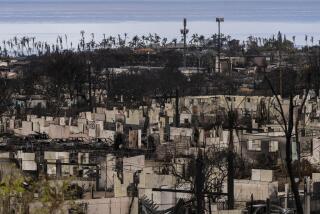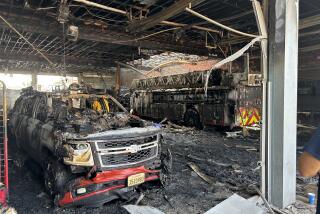Sorry, Viewers, No Nuclear Crisis After All
A local cable-TV carrier erroneously reported a nuclear emergency at the San Onofre Nuclear Generating Station on Wednesday, prompting more than 200 South County residents to call law enforcement and utility officials to find out what was happening.
“I would say that it was more than a handful, but certainly not a flood,” Dick Waterman, a spokesman for Cox Communications, Orange County, said of the calls his company received after the 10:15 a.m. report.
The error was triggered by a routine annual test of the plant’s 49 warning sirens within the 10-mile radius that includes Dana Point, San Clemente, San Juan Capistrano and parts of San Diego County, Waterman said. Ordinarily, he said, viewers of Cox’s 45 channels in the area are alerted by a written message scrolling across their TV screens that the sirens are part of a test. On Wednesday, an encoded signal from a San Clemente radio station automatically triggered the wrong message, announcing instead that there was an emergency.
“It’s one of those kinds of things that you sure hope doesn’t happen,” Waterman said. “We’re not trying to put any blame on anybody on this, but we don’t feel that any blame should be put on us either.”
The cable company later broadcast a correction.
Steven Conroy, a spokesman for Southern California Edison, which operates the San Clemente nuclear plant, said the incident was the first of its kind since San Onofre began conducting the required periodic testing in the 1970s. “We don’t know what happened,” he said. “Obviously, we’re very concerned when misinformation goes out to the public regarding any activities surrounding the annual siren test.”
He said the test was preceded by announcements sent to 55,800 homes, 3,700 businesses, 18 public schools, nine private schools and several media outlets, including Cox Communications. But something went amiss, Conroy said, when San Clemente radio station KWVE-FM (107.9), which anchors the area’s emergency preparedness system, sent out an encoded signal that automatically triggered the erroneous broadcast at Cox.
“They normally go off without a hitch,” Conroy said of the annual tests.
Robert Cadman, KWVE’s general manager and chairman of the Emergency Alert System’s local emergencies committee of Orange County, said he is looking into just what went wrong. “The test was run exactly as it was last year,” he said, “and there were no problems then.”
One possibility, he said, is a Federal Communications Commission rule that took effect Jan. 1 requiring cable companies such as Cox to install automated emergency broadcasting equipment. “Something has obviously changed in the way they handled the information last year as opposed to this year,” he said of Cox.
Cadman said he thinks the problem can be fixed by changing the computer software that generates the radio station’s emergency code. “We’ve had several meetings already looking into the system to see if the software can be rewritten,” he said. “We expect the problem to be corrected within weeks. That’s why they call them tests--to let these kinds of issues surface now instead of in an actual emergency.”
Officials at the cable company and Edison, meanwhile, spent part of Wednesday afternoon reassuring customers and reporters that the nuclear power plant was operating normally.
“The test went very well,” Conroy said, “although, obviously, the misinformation didn’t go well. We are certainly hoping that whatever went wrong will be corrected and not ever happen again.”
More to Read
Sign up for Essential California
The most important California stories and recommendations in your inbox every morning.
You may occasionally receive promotional content from the Los Angeles Times.









